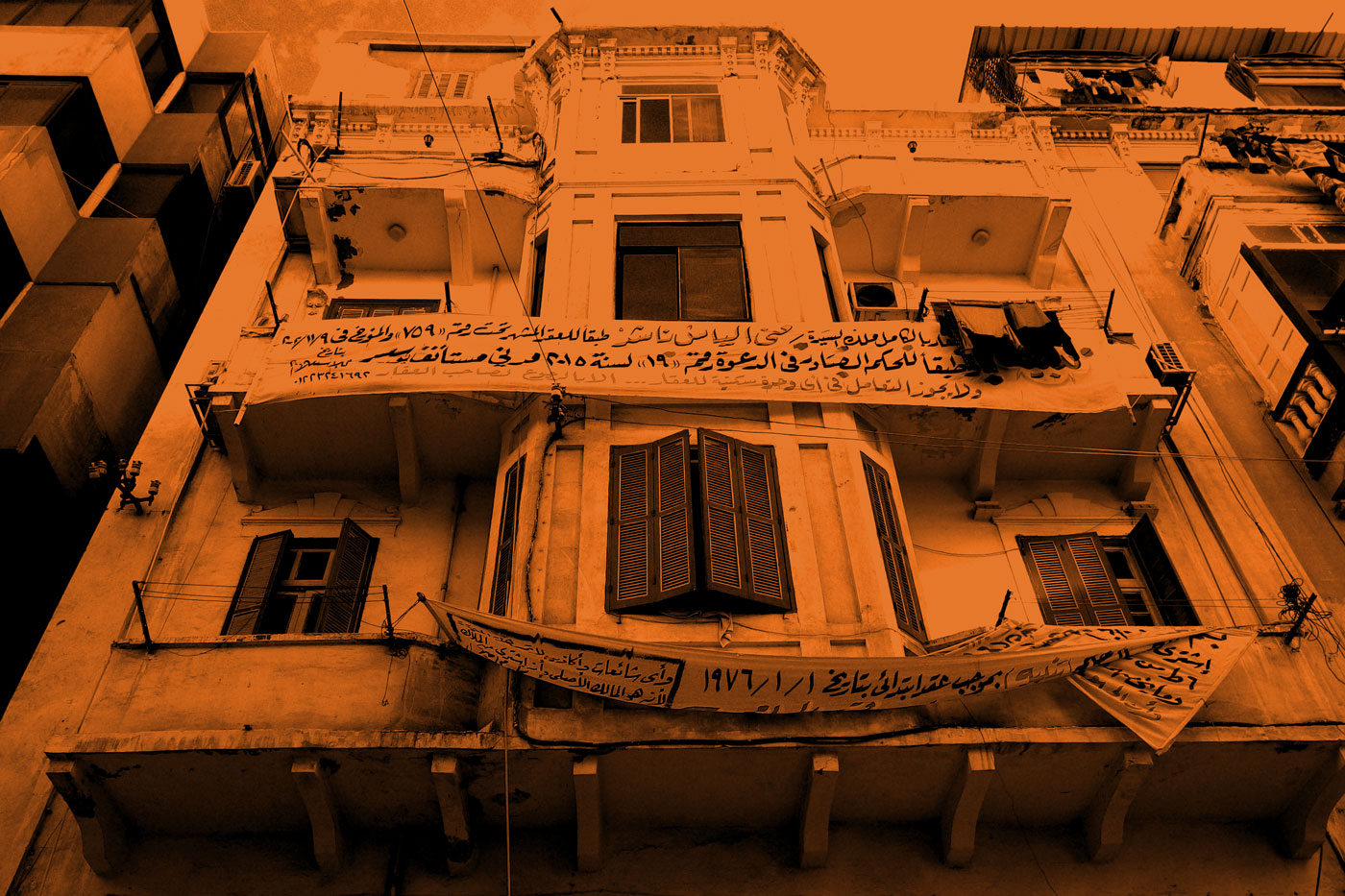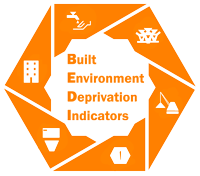Safe Water
Table of Contents

Summary
About 17% of Egyptian households are deprived of access to safe water. The highest incidence is in Upper Egypt, where deprivation ranges from 19% to 46%. About 2.3 million households (13.3% of the population) do not have access to a tap inside their dwelling,[1] and depend on transporting water to the home. Access to taps does not automatically mean that the water is sufficient or fit to drink. 20% of Egyptians do not receive the sufficient national average of 152 litres/person/day.[2] In five out of 27 governorates over 25% of water samples failed quality tests.[3]
How is the lack of access to safe water a problem?
The main problem with deprivation from safe water is water pollution. UNICEF estimated that acute diarrheal disease caused by the lack of access to safe water and proper sanitation services as well as poor hygiene leads to 4500 cases of death in children under five in Egypt each year.[4] One of the more recent cases of mass water pollution was when hundreds of residents of the village of San-Saft in Munufia were treated for Salmonella and E coli infections related to improperly treated drinking water.[5]
Another problem associated with deprivation from safe water is the physical effort needed to carry water, particularly for women and girls. “The lack of safe drinking water within or close to the home can mean long journeys to collect water at remote water points often to the detriment of their education, along with the risk of being subjected to harassment and other threats along the way”.[6] Indeed 6% of women and girls in Egypt spend up to five or six hours daily collecting water.[7]
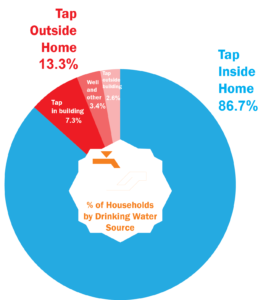
Source: CAPMAS 2008. 2006 Census of Population and Living Conditions. Household Access to Sources of Drinking Water
Buying water can be very expensive when you do not have a tap inside your home, you experience severe water cuts or find it is not fit to drink. According to UNICEF, 1.5 million Egyptians have to buy water from tanker trucks.[8] The average household pays a municipal water bill of EGP 13 per month (not including sanitation services). However in the event that water needed for just drinking and cooking is bought from vendors, it would cost almost 17 times more (Table x). Bottled water would cost 170 times more for the same uses.
Table 1: Comparison of costs of water based on source
| Per Person | Per Household (4.2 people) | Municipal Water | Jerry Cans | Bottled Water | |||||
| Typical Water Consumption | Day | Month | Month | EGP/ litre | EGP | EGP/ litre | EGP | EGP/ litre | EGP |
| Litres | Litres | Litres | |||||||
| All uses | 150 | 4500 | 18,900 | 0.0007 | 13.2 | 0.175 | 3308 | 1.4 | 25,893 |
| Drinking & cooking | 10 | 300 | 1260 | 0.0007 | 0.9 | 0.175 | 221 | 1.4 | 1726 |
| *Municipal water rates based on the second tier for water use of EGP 0.7 per cubic meter as per Akhbar al-Youm. “Al-As’ar al-gadida li shara’eh miyah al-shurb” 01.02.2016 http://tinyurl.com/zc9un78 ** Vendor water rates based on the price per litre of one jerry can (20 litres) of between EGP 3 – 4 on 14.07.2016 as per Al-Shorouk. “Jerkin al-miyah bi 4 gunayhat fil-muhafazat”. 14.07.2016 http://www.shorouknews.com/news/view.aspx?cdate=14072016&id=7f577c38-d1d1-4d95-b9f7-5d68ae1b0db3 *** Bottled water rates calculated per litre based on a gallon (18.9 litre) bottle bought in bulk on 01.10.2016. Nestle Pure Life http://menuegypt.com/Nestle |
|||||||||
Who lack access to safe water in Egypt?
Deprivation from safe water was highest in the two mostly rural regions of Egypt: between 19% to 46% in Upper Egypt, and between 0.5% and 25% in the Delta. That is in contrast to the Capital, Cairo, where it was 2.8%. Overall the most severely affected governorate was Minya (46% deprivation).
Households that lacked a tap inside their home were highest in Upper Egypt, where deprivation ranged between 8% in Luxor and 40% in Minya. On the local level the two most deprived Markaz (districts) were Al-Qasima and Al-Hasnah in North Sinai where 97% and 96% of households did not have a tap inside their homes. Unsurprisingly the Markaz with the highest number of households without a tap was in Minya, with 81,556 households deprived in Markaz al-Minya.
Water scarcity was also highest in Upper Egypt where the governorates of Luxor and Minya received between 26% and 51% less water than the average official daily per capita rate of 152 litres per person per day.
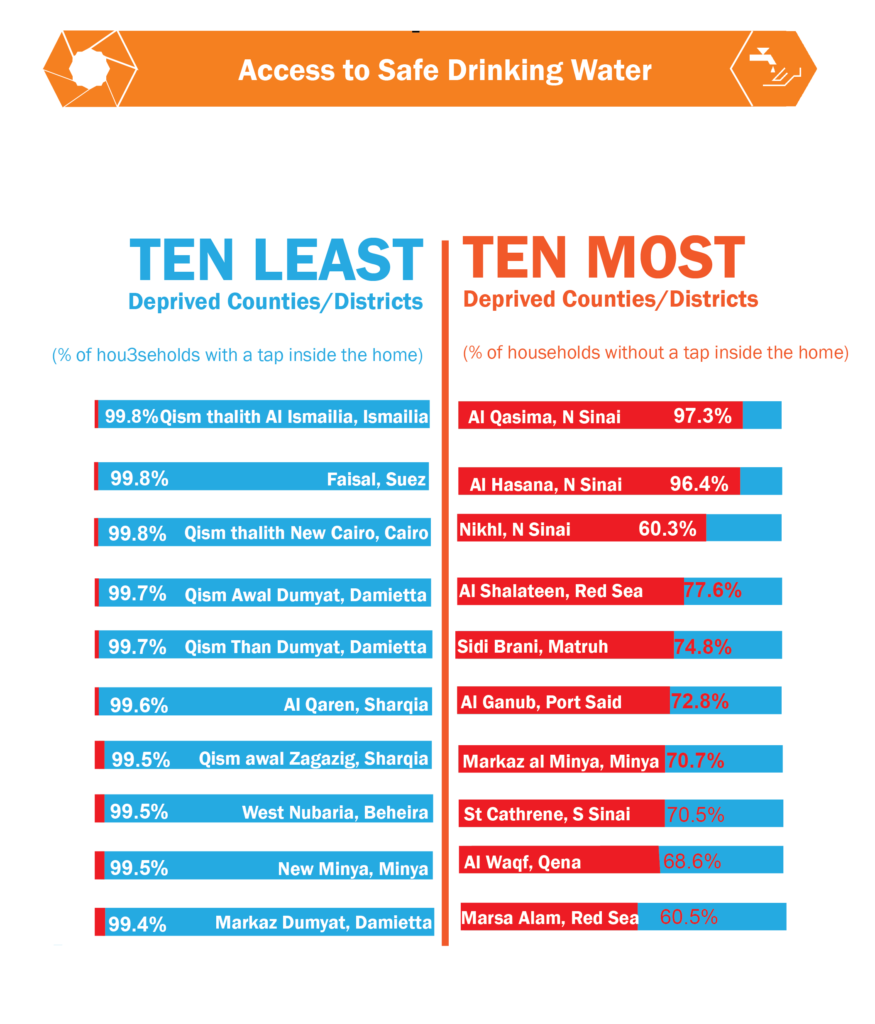
Source: CAPMAS 2008. 2006 Census of Population and Living Conditions. Household Access to Sources of Drinking Water
Why do people lack access to safe water?
Lack of resources and/or their misappropriation has led to unbalanced investments in drinking water infrastructure.[9] This in turn leads to villages not being served, water production not coping with population growth, or the decay of networks.
Clusters of villages in Minya in Upper Egypt experienced severe water shortages in the summer because drinking water plants were not producing enough water,[10] a fact reflected in how the average per capita water consumption was 73 litres per person per day, or less than half the national average.
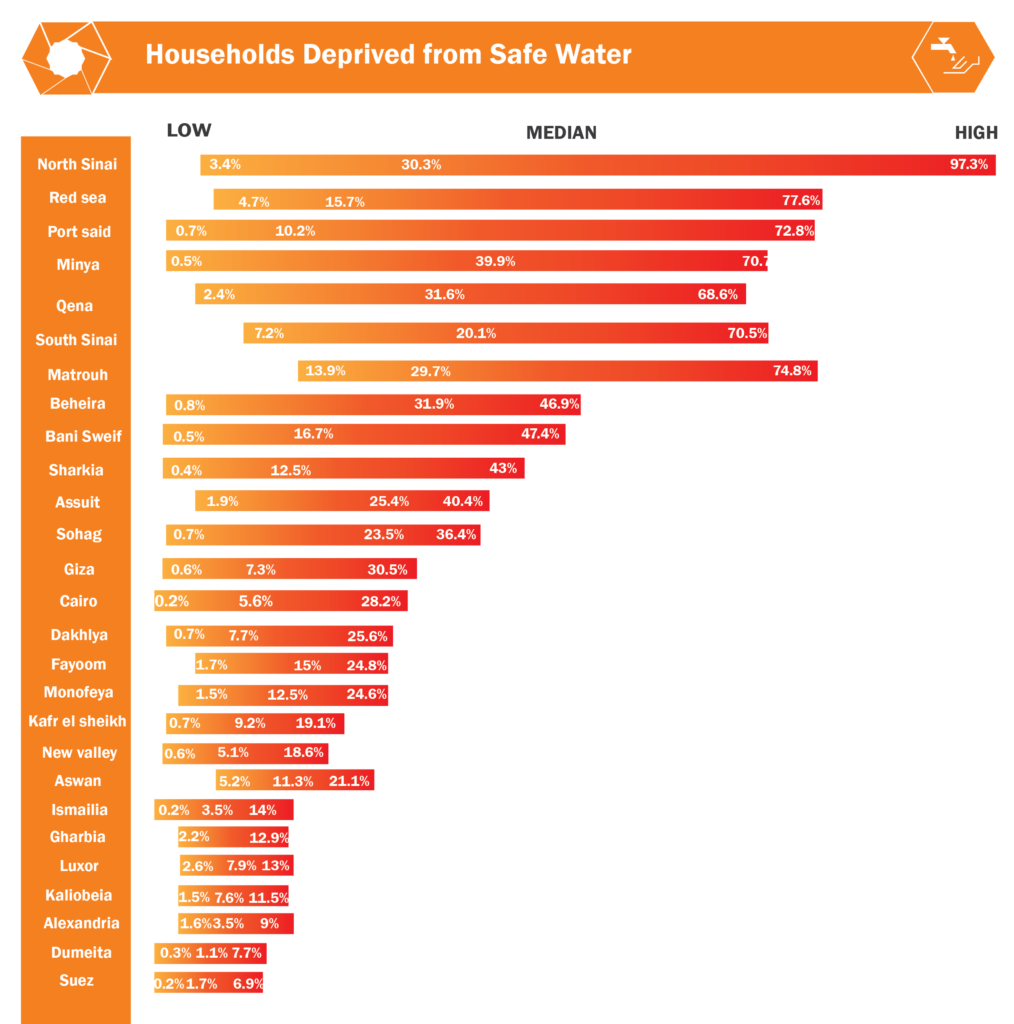
Source: CAPMAS 2008. 2006 Census of Population and Living Conditions. Household Access to Sources of Drinking Water
What can be done?
- Introduce program to provide water taps within housing units deprived of them.
- Widen current program to build water plants and networks in deprived areas through direct cross-subsidization from state land sales prioritizing the most deprived areas.
Methodology
Definitions:
Access to safe drinking water is one of the aspects of safe housing since “adequate housing must provide more than four walls and a roof”.[11] The right to adequate housing does not just mean that the structure of the house itself must be adequate, but also ensures that a sustainable and non-discriminatory access to facilities is essential for health, security, comfort and nutrition. One of the major facilities essential for life is the access to safe drinking water.[12]
The committee on Economic, Social and Cultural Rights defined the right to water in general comment 15/2002 as; “…the right to maintain access to existing water supplies necessary for the right to water, and the right to be free from interference, such as the right to be free from arbitrary disconnections or contamination of water supplies. By contrast, the entitlements include the right to a system of water supply and management that provides equality of opportunity for people to enjoy the right to water”.
Measurement Tools:
The United Nations General Assembly explicitly recognized the human right to water and sanitation in 2010 through Resolution 64/292, defining five basic elements of right to water:[13]
- Sufficient: The water supply for each person must be sufficient and continuous for personal and domestic uses. These uses ordinarily include drinking, personal sanitation, washing of clothes, food preparation, personal and household hygiene. According to the World Health Organization (WHO), between 50 and 100 litres of water per person per day are needed to ensure that most basic needs are met and few health concerns arise.
- Safe: The water required for each personal or domestic use must be safe, meaning free from micro-organisms, chemical substances and radiological hazards that constitute a threat to a person’s health. Measures of drinking-water safety are usually defined by national and/or local standards for drinking-water quality. The World Health Organization (WHO) Guidelines for drinking-water quality provide a basis for the development of national standards that, if properly implemented, will ensure the safety of drinking-water.
- Acceptable: Water should be of an acceptable colour, odour and taste for each personal or domestic use. […] All water facilities and services must be culturally appropriate and sensitive to gender, lifecycle and privacy requirements.
- Physically accessible: Everyone has the right to a water and sanitation service that is physically accessible within, or in the immediate vicinity of the household, educational institution, workplace or health institution. According to WHO, the water source has to be within 1,000 metres of the home and collection time should not exceed 30 minutes.
- Affordable: Water, and water facilities and services, must be affordable for all. The United Nations Development Programme (UNDP) suggests that water costs should not exceed 3 per cent of household income.
The United Nations Human Settlements Programme (Un-Habitat) measures the acess to water on the national level simply as the:[14] “Proportion of the population with sustainable access to an improved water source.” The following types of water supply qualify as an improved water source: piped water; public tap; borehole or pump; protected well; protected spring or rainwater. Vendor-provided water, bottled water, tanker trucks or unprotected wells and springs are not considered improved water sources.
Methodology for calculating access to safe water indicator in Egypt
Based on the UN organisations’ definitions of access to safe water, along with data available in Egypt, we used a compound indicator of two data sets to measure deprivation from safe water:
- Accessibility: Percentage of households in each governorate with a tap inside the dwelling. This has been based on 2006 census figures provided by CAPMAS.[15] We excluded all households who have access to water through taps in the building, or from shared taps outside the building as well as boreholes, pumps and wells.
- Water consumption per capita: Percentage of meeting the average official water use per day of 152 litres per person in each governorate.[16] This is based on official statistics gathered and averaged over three consecutive years to balance any shortfalls in data.[17]
Percentages of depravation were averaged out between the two sub indicators to achieve the indicator of deprivation from safe water.
Footnotes
[1] CAPMAS 2008. 2006 Census of Population and Living Conditions. Household Access to Sources of Drinking Water. [2] CAPMAS. Annual Statistical Report on Drinking Water and Sanitation 2011/2012 to 2013/2014 [3] CAPMAS 2015. Annual Statistical Report on Drinking Water and Sanitation 2013/2014 [4] Unicef Egypt. Water, Sanitation and Hygiene. n.d. http://www.unicef.org/egypt/immunisation_7135.html [5] "Victims of the tap", al-Ahram Weekly, 30 Aug - 5 Sept 2012 http://weekly.ahram.org.eg/Archive/2012/1112/eg4.htm [6] United Nations High Commissioner for Human Rights. The Right to Adequate Housing. Geneva, May 2014 [7] Unicef Egypt. Water, Sanitation and Hygiene. n.d. http://www.unicef.org/egypt/immunisation_7135.html [8] “For first time in Egypt, UNICEF uses click-funding to seek higher donations for its campaign”, Daily News Egypt, 21.02.0216 http://www.dailynewsegypt.com/2016/02/21/for-first-time-in-egypt-unicef-uses-click-funding-to-seek-higher-donations-for-its-campaign/ [9] Shawkat, Y and Khali, A. The Built Environment Budget 2015/16 | An Analysis of Spatial Justice in Egypt. 10 Tooba, Cairo. June 2016 http://www.10tooba.org/en/?p=172 [10] “Azmat al-'atash: muzahrat bil-jarakin.. wa qat'a turuq fil-muhafazat", Al-Watan, 15.06.2016 http://www.elwatannews.com/news/details/1226904 [11] United Nations High Commissioner for Human Rights. The Right to Adequate Housing. Geneva, May 2014 [12] United Nations High Commissioner for Human Rights. The Right to Adequate Housing. Geneva, May 2014 [13] UN n.d. Water for Life Decade, Human Right to Water. http://www.un.org/waterforlifedecade/human_right_to_water.shtml Accessed 01.09.2016 [14] UNHABITAT. Water & Sanitation. n.d. http://unhabitat.org/urban-themes/water-and-sanitation-2/ [15] CAPMAS 2008. 2006 Census of Population and Living Conditions. Household Access to Sources of Drinking Water. [16] The Egyptian Code for Water and Sanitation states that drinking water plants should be designed to provide a net household share of 125, 150 and 180 litres/person/day in villages, towns (Marakez), provincial capitals and New Cities. Egyptian Code for Water and Sanitation, Housing & Building Research Center, Cairo. 1998. P26 [17] CAPMAS. Annual Statistical Report on Drinking Water and Sanitation 2011/2012 to 2013/2014
